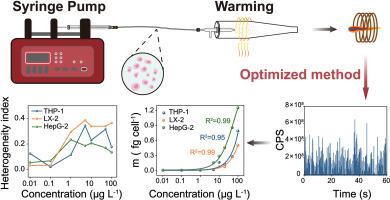Detection of Mercury in Single Mammalian Cells at Attogram Level by SC-ICP-MS
IF 6
2区 化学
Q1 CHEMISTRY, ANALYTICAL
引用次数: 0
Abstract
Background
Mercury (Hg), a global pollutant, poses health risks to humans and mammals even at low exposure levels. However, current analytical methods face challenges in quantifying cellular Hg at ultralow concentrations. In this study, we developed a sensitive single-cell inductively coupled plasma-mass spectrometry (SC-ICP-MS) method by utilize a temperature-controlled introduction system to trace Hg in individual mammalian cells.Results
Sensitivity was significantly enhanced through a personalized tuning process, which increased the instrument sensitivity of Hg ions (Hg2+) by 28.8%. Through optimization of detection conditions, we achieved an improved transport efficiency (TE) of 27.3% for single-cell detection in THP-1 cells. By implementing the comprehensively optimized method, we attained an exceptionally low single-cell-level Hg mass detection limit (LODm) of 0.01 fg per cell, coupled with a cell density detection limit (LODd) of 8.1×102 cells mL-1, resulting in a Hg concentration detection limit (LODc) of 0.008 ng L-1. This validated method demonstrated robust applicability across multiple mammalian cell types, revealing that Hg content (m) at the single-cell level exhibited exponential growth with increasing exposure concentration, while the heterogeneity of Hg displayed an initial rise before reaching a plateau or decreasing.Significance
This study establishes a highly sensitive and reproducible method for monitoring single-cell Hg content and heterogeneity at environmentally low exposure levels. The technical advances provide a robust methodological foundation for assessing element-specific toxicity across different mammalian cell types, supporting the health risk evaluation in low-dose scenarios.

SC-ICP-MS法测定哺乳动物细胞中汞含量
汞是一种全球性污染物,即使在低水平接触下也会对人类和哺乳动物造成健康风险。然而,目前的分析方法面临着在超低浓度下定量细胞汞的挑战。在这项研究中,我们建立了一种敏感的单细胞电感耦合等离子体质谱(SC-ICP-MS)方法,利用温度控制的引入系统来追踪单个哺乳动物细胞中的汞。结果通过个性化调谐工艺,仪器对Hg离子(Hg2+)的灵敏度提高了28.8%。通过优化检测条件,我们将THP-1细胞单细胞检测的转运效率(TE)提高了27.3%。通过实施综合优化方法,我们获得了极低的单细胞水平汞质量检测限(LODm)为0.01 fg / cell,加上细胞密度检测限(LODd)为8.1×102 cells mL-1,从而获得了汞浓度检测限(LODc)为0.008 ng L-1。结果表明,单细胞水平的汞含量(m)随着暴露浓度的增加呈指数增长,而汞的异质性在达到平台期或下降之前呈初始上升趋势。本研究建立了一种在环境低暴露水平下监测单细胞汞含量和异质性的高灵敏度和可重复性方法。技术进步为评估不同哺乳动物细胞类型中元素特异性毒性提供了坚实的方法学基础,支持在低剂量情况下进行健康风险评估。
本文章由计算机程序翻译,如有差异,请以英文原文为准。
求助全文
约1分钟内获得全文
求助全文
来源期刊

Analytica Chimica Acta
化学-分析化学
CiteScore
10.40
自引率
6.50%
发文量
1081
审稿时长
38 days
期刊介绍:
Analytica Chimica Acta has an open access mirror journal Analytica Chimica Acta: X, sharing the same aims and scope, editorial team, submission system and rigorous peer review.
Analytica Chimica Acta provides a forum for the rapid publication of original research, and critical, comprehensive reviews dealing with all aspects of fundamental and applied modern analytical chemistry. The journal welcomes the submission of research papers which report studies concerning the development of new and significant analytical methodologies. In determining the suitability of submitted articles for publication, particular scrutiny will be placed on the degree of novelty and impact of the research and the extent to which it adds to the existing body of knowledge in analytical chemistry.
 求助内容:
求助内容: 应助结果提醒方式:
应助结果提醒方式:


